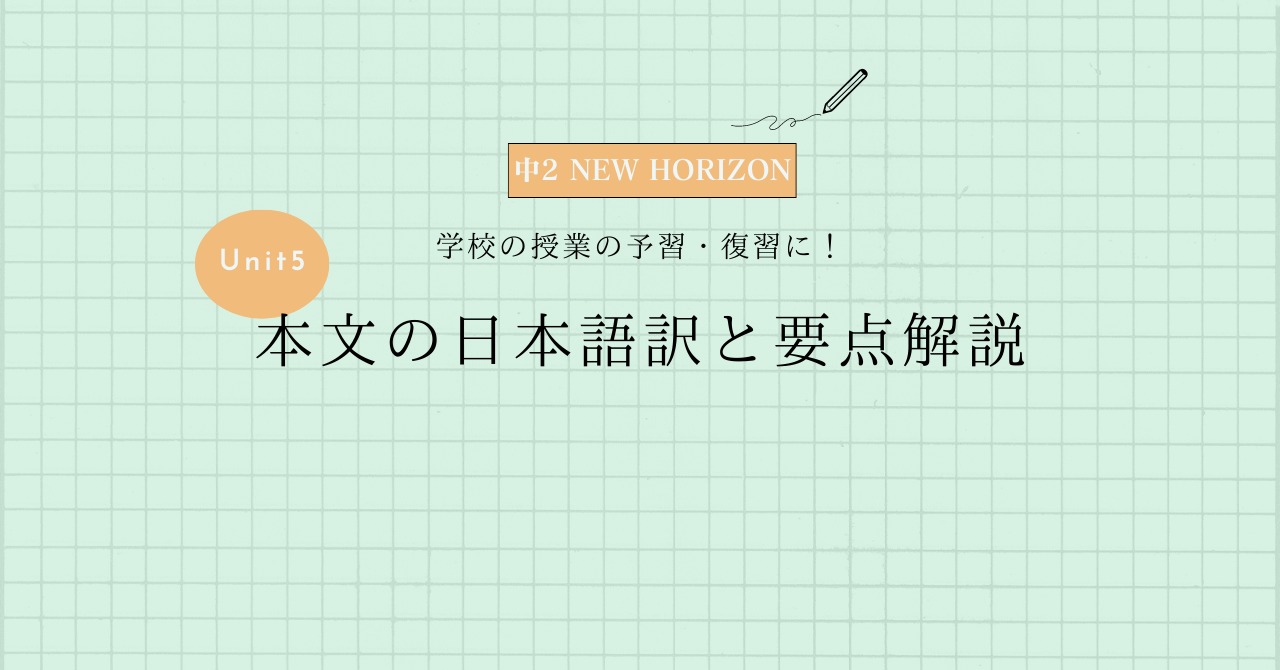東京書籍 中学2年生 NEW HORIZON(ニューホライズン) Unit5 Read & Think1の本文の日本語訳と重要箇所の解説です。
Unit5-1, 5-2とRead & Think2の解説はこちらからご覧ください。
>中2NEW HORIZON Unit5 Scene1 本文和訳
>中2NEW HORIZON Unit5 Scene2 本文和訳
>中2NEW HORIZON Unit5 Read & Think2 本文和訳
- Unit5 Read & Think1 本文と日本語訳
- Unit5 Read & Think1 重要事項の解説
- What is Meg introducing?
- “Universal” means “for all people.”
- Look at this plastic bottle.
- We can hold it easily because it has a special shape.
- It’s a common example of universal design.
- I’m glad that I could find other examples in our city.
- Look at these pictures. Do you see the braille on the handrail?
- People can read it with their fingers.
- Do you see the ramp by the stairs?
- If you’re in a wheelchair, or pulling heavy luggage, you can use the ramp.
- It also helps the elderly and people with babies and small children.
- I think these ideas are wonderful.
- I’m sure that they help many people.
- Unit5 Read & Think1 まとめ
Unit5 Read & Think1 本文と日本語訳
What is Meg introducing?
「メグは何を紹介していますか?」
Do you know about universal design?
「ユニバーサルデザインについて知っていますか?」
“Universal” means “for all people.”
「『ユニバーサル』は『すべての人のため』という意味です。」
Look at this plastic bottle.
「このペットボトルを見てください。」
We can hold it easily because it has a special shape.
「ペットボトルは特別な形をしているので簡単に掴むことができます。」
It’s a common example of universal design.
「それはユニバーサルデザインのよくある例です。」
I’m glad that I could find other examples in our city.
「自分たちの町で他の例を見つけることができて私は嬉しいです。」
Look at these pictures. Do you see the braille on the handrail?
「これらの写真を見てください。手すりの点字は見えますか?」
People can read it with their fingers.
「指を使ってそれを読むことができます。」
Do you see the ramp by the stairs?
「階段のそばの斜面は見えますか?」
If you’re in a wheelchair, or pulling heavy luggage, you can use the ramp.
「もしあなたが車いすに乗っていたり,重い荷物を引いていたら,その斜面を利用できます。」
It also helps the elderly and people with babies and small children.
「また,それは高齢者や赤ちゃん,小さい子どもと一緒にいる人にも役立ちます。」
I think these ideas are wonderful.
「こういったアイディアは素晴らしいと思います。」
I’m sure that they help many people.
「きっと多くの人を助けていると思います。」

Unit5 Read & Think1 重要事項の解説
What is Meg introducing?
この文では「現在進行形」が使われていますね。
“introduce”は「を説明する」という動詞になります。
“Universal” means “for all people.”
“universal”は「世界中の,万人の」という形容詞で,“mean”は「を意味する」という動詞になります。
Look at this plastic bottle.
“plastic”は「プラスチックの,ビニールの」という形容詞になります。
“plastic bottle”で「ペットボトル」という意味ですね。
We can hold it easily because it has a special shape.
“hold”は「を掴む,開催する」という動詞です。“it”は“plastic bottle“を指していますね。
“easily”は「簡単に,容易に」という副詞になります。
また,この文では「接続詞because」も使われていますね。
“special”は「特別な」という形容詞で,“shape”は「形」という名詞です。
It’s a common example of universal design.
この文の“it”も“plastic bottle“を指していますね。
“common”は「一般的な,よくある,共通の」といった形容詞で,“example”は「例,たとえ」という名詞になります。
“design”は「デザイン,設計」という名詞ですね。
I’m glad that I could find other examples in our city.
“glad”は「嬉しい」という形容詞で,「形容詞+接続詞that」の形で「その形容詞の状態になる理由・原因」を表現できます。
“find”は「を見つける」という動詞で,“other”は「他の」という形容詞ですね。
Look at these pictures. Do you see the braille on the handrail?
“these”は“this”の複数形で「これらは,これらの」という意味です。
“braille”は「点字」,“handrail”は「手すり」という名詞ですね。
People can read it with their fingers.
“it”は“the braille“を指していますね。
“with”は前置詞で「~と一緒に」と訳すことが多いですが,必ずしも後ろに人が来るわけではありません。イメージとして「~とセットで」と覚えておきましょう。
訳し方としては「~を使って」「~で」など文脈に合わせて柔軟に変えてあげましょう。
“finger”は「指」という名詞です。
Do you see the ramp by the stairs?
“ramp”は「斜面,傾斜」,“stair”はふつう複数形で使って「階段」という名詞になります。
“by”は前置詞で今回は「~のそばで」と訳しますが,他にも様々な意味があるので必ず覚えておきましょう!
1.受動態とセットで「~によって」
2.”by+乗り物”で「交通手段」
3.「~までに」という期限
4.「~のそばに」という場所を表す
If you’re in a wheelchair, or pulling heavy luggage, you can use the ramp.
この文では「接続詞if」が使われていますね。
“wheelchair”は「車いす」という名詞で,“pull”は「を引く」という動詞です。
“pulling”は“are”と繋がって,「現在進行形」になっていますね。
“heavy”は「重い」という形容詞で,“luggage”は「荷物」という名詞で,スーツケースのような旅行用の荷物を指します。
It also helps the elderly and people with babies and small children.
“also”は「また,さらに」といった副詞で,付け加える役割があります。色々な文で使うので必ず覚えましょう!
“elderly”は冠詞の“the”とセットで「高齢者」という名詞になります。形容詞で「高齢の,年配の」という意味もありますよ。
I think these ideas are wonderful.
この文では「接続詞that」が“think”の後ろに省略されていますね。
“wonderful”は「素晴らしい」という形容詞になります。
I’m sure that they help many people.
“sure”は「確信して,確かな」という形容詞になります。「もちろん」という肯定の返事としても使いますね。
“be sure that~”は「きっと~だと思う」という意味です。「接続詞that」は省略してもOKです。
“they”は“these ideas”を指していますね。
Unit5 Read & Think1 まとめ
以上がUnit5 Read & Think1の日本語訳となります。
ここでは「接続詞」を使った表現が多く使われていますね。しっかり理解していきましょう!
>中2NEW HORIZON Unit5 Scene1 本文和訳
>中2NEW HORIZON Unit5 Scene2 本文和訳
>中2NEW HORIZON Unit5 Read & Think2 本文和訳
何か分からない点や他に解説してほしい点があれば,お気軽にコメントしてください!



コメント